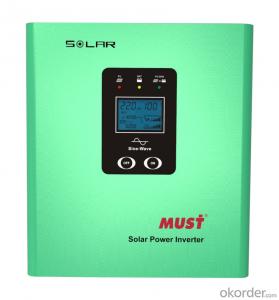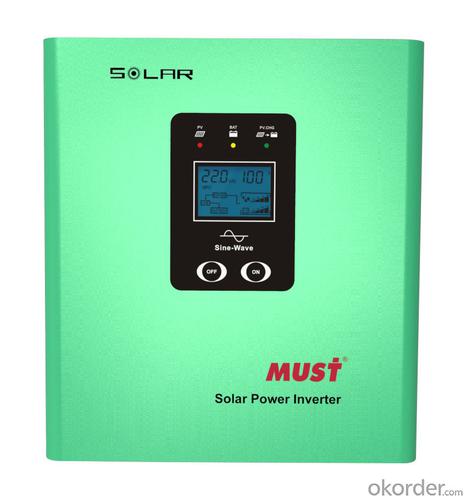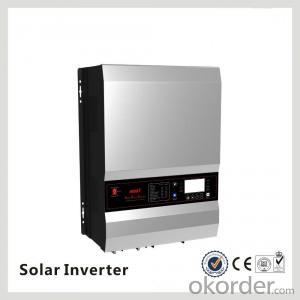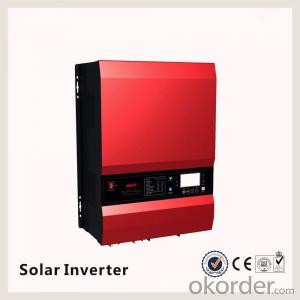Low Frequency Power Inverter CE Approved New Function PV 2000 1200VA/700W
- Loading Port:
- Ningbo
- Payment Terms:
- TT OR LC
- Min Order Qty:
- 500 pc
- Supply Capability:
- 10000 pc/month
OKorder Service Pledge
OKorder Financial Service
You Might Also Like
Pure sine wave solar inverter inbuilt with 30A solar charge controller
.Inbuilt with AVR function
.Solar first, high efficiency use of energy , Automatically charge from Grid power when insufficient PV Power
.Full protections for battery and inverter
.Suitable for home , different color options
.Controller efficiency max 90%
| MODEL | PV20-500 | PV20-1200 | PV20-2000 | ||||
| Default Battery System Voltage | 12VDC | 12VDC | 24VDC | ||||
| INVERTER OUTPUT | Rated Power | 500VA/300W | 1200VA/700W | 2000VA/1200W | |||
| Surge Rating (20ms) | 900W | 2100W | 3600W | ||||
| Waveform | Pure sine wave | ||||||
| Nominal Output Voltage RMS | 220VAC(+/-10% RMS) | ||||||
| Output Frequency | 50Hz/60Hz +/-1 Hz | ||||||
| Inverter Efficiency(Peak) | >80% | ||||||
| Line Mode Efficiency | >95% | ||||||
| Typical Transfer Time | Typical 2~6ms 10ms(max) | ||||||
| AC INPUT | Voltage | 220VAC | |||||
| Selectable Voltage Range | 140~275VAC(For Personal Computers) | ||||||
| Frequency Range | 50HZ/60HZ (Auto sensing 47~65Hz) | ||||||
| BATTERY | Minimum Start Voltage | 10.5VDC | 21.0VDC | ||||
| Low Battery Slarm | 10.5VDC+/-0.3V | 21.0VDC+/-0.6V | |||||
| Low Battery Cutoff | 10.0VDC+/-0.3V | 20.0VDC+/-0.6V | |||||
| High Voltage Alarm | 15.5VDC+/-0.3V | 31.0VDC+/-0.6V | |||||
| High Battery Voltage Recover | 15.0VDC+/-0.3V | 30.0VDC+/-0.6V | |||||
| CHARGER | Charger Voltage | 14.0±0.2V | 28.0V±0.2V | ||||
| Overcharge Protection S.D. | 15.5VDC | 31.0VDC | |||||
| Maximum Charge Current | 10A MAX | ||||||
| BYPASS & PROTECTION | Input Voltage Waveform | Sine wave | |||||
| Nominal Input Frequency | 50Hz or 60Hz | ||||||
| Low Freq Trip | 47+/-0.3Hz for 50Hz; 57+/-0.3Hz for 60Hz | ||||||
| High Freq Trip | 55+/-0.3Hz for 50Hz; 65+/-0.3Hz for 60Hz | ||||||
| Overload Protection (SMPS Load) | Load>110% R Load fault after 60S | ||||||
| Output Short Circuit Protection | AC FUSE Protection | ||||||
| Bypass Breaker Rating | 10A | ||||||
| Max Bypass Current | 10Amp | ||||||
| SOLAR CHARGER | Maximum PV Charge Current | 30A | |||||
| DC Voltage | 12V/24V atuo work | ||||||
| Maximum PV Array Power | 150W*3 solar panels | 150W*4 solar panels | |||||
| MPPT Range @ Operating Voltage | 16~55VDC | ||||||
| Maximum PV Array Open Circuit Voltage | 55VDC | ||||||
| Maximum Efficiency | >95% | ||||||
| Standby Power Consumption | <2W | ||||||
| MECHANICAL SPECIFICATIONS | Mounting | Wall mount | |||||
| Dimensions (W*H*D) | 301*328*132mm | ||||||
| Net Weight (Solar CHG) kg | 6.86KG | 8.92KG | 10.25KG | ||||
| Shipping Dimensions(W*H*D) | 325*391*187mm | ||||||
| Shipping Weight (Solar CHG) kg | 7.54KG | 9.6KG | 10.93KG | ||||
| OTHER | Operating Environment | 0°C~40°C 0~90% relative humidity (non-condensing) | |||||
| Noise Level | Less than 60dB | ||||||
| Display | LED+LCD | ||||||
| Standard Warranty | 1 year | ||||||

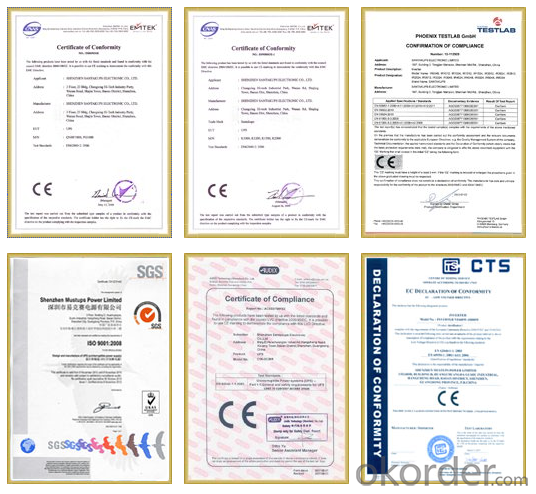
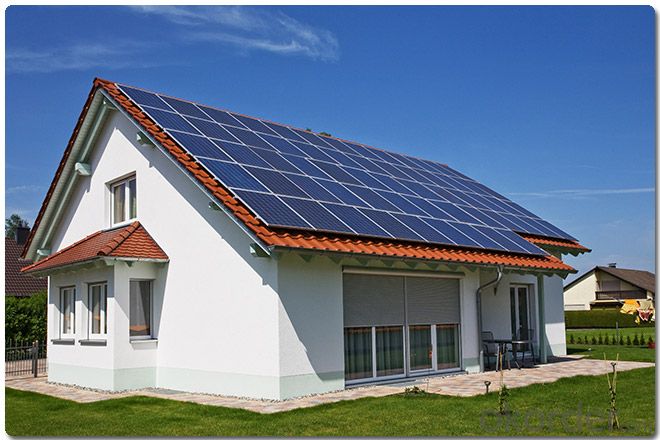
Warrenty
provides a 1~3 year limited warranty (“Warranty”) against defects in materials and workmanship for its Uninterruptible power supply, Power inverter/chargers, Solar charge controllers, Battery Products (“Product”).
The term of this Warranty begins on the Product(s) initial purchase date, or the date of receipt of the Product(s) by the end user, whichever is later. This must be indicated on the invoice, bill of sale, and/or warranty registration card submitted to MUST-Solar. This Warranty applies to the original MUST-Solar Product purchaser, and is transferable only if the Product remains installed in the original use location.
FAQ
1. How do I decide which system is right for me ?
For protection from long outages, include a generator or solar panels in your Must solar system. Shorter outages can be handled by a battery-only system.
2. Where my system will be installed ?
Must solar systems are usually wall-mounted near a home's main electrical (circuit breaker) panel.
3. How do I install my system ?
A must solar backup inverter is connected to a home electric system , we will supply detailed installation manual and videos for our customers .
- Q: What is the role of a solar inverter in a utility-scale system?
- The role of a solar inverter in a utility-scale system is to convert the direct current (DC) electricity produced by solar panels into alternating current (AC) electricity that can be used by the utility grid. In addition to this basic function, a solar inverter also monitors and controls the performance of the solar panels, ensures maximum power generation, and provides safety features such as grid synchronization and protection against voltage fluctuations.
- Q: Can a solar inverter be used with battery storage?
- Yes, a solar inverter can be used with battery storage. In fact, integrating a solar inverter with battery storage systems allows for storing excess solar energy generated during the day and using it at night or during times of high energy demand. This combination enables greater energy independence and the ability to use renewable energy even when the sun is not shining.
- Q: How does a solar inverter handle grid frequency deviations?
- A solar inverter handles grid frequency deviations by constantly monitoring the grid frequency. When the grid frequency deviates from the standard range, the inverter adjusts its output frequency accordingly to match the grid frequency. This allows the inverter to maintain synchronization with the grid and continue injecting power efficiently, ensuring stability and reliability of the solar power system.
- Q: Can a solar inverter be used in a multi-string configuration?
- Yes, a solar inverter can be used in a multi-string configuration. In fact, many solar installations utilize multiple strings of solar panels connected to a single inverter. This allows for increased efficiency, flexibility, and the ability to harvest more energy from the sun.
- Q: How do you choose the right size solar inverter for your system?
- To choose the right size solar inverter for your system, you need to consider two key factors: the maximum power output of your solar panels and the maximum power demand of your electrical appliances. The solar inverter should be able to handle the peak power output of your solar panels and should have a capacity slightly higher than the maximum power demand of your appliances. It is important to ensure a proper match between the solar inverter and your system's power requirements to optimize energy production and ensure efficient operation.
- Q: Can a solar inverter be used in a ground-mounted solar system?
- Yes, a solar inverter can be used in a ground-mounted solar system. In fact, ground-mounted solar systems commonly utilize solar inverters to convert the direct current (DC) generated by the solar panels into alternating current (AC) that can be used to power homes or businesses or fed back into the electrical grid.
- Q: What is the role of a transformer in a solar inverter?
- The role of a transformer in a solar inverter is to convert the direct current (DC) electricity generated by the solar panels into alternating current (AC) electricity suitable for use in homes and businesses. The transformer helps to step up or step down the voltage levels, ensuring efficient and safe transmission of electricity from the solar panels to the electrical grid or connected loads.
- Q: How does a solar inverter handle frequency variations in the grid?
- A solar inverter handles frequency variations in the grid by continuously monitoring the frequency and adjusting its own output accordingly. When the grid frequency increases, the inverter reduces its output frequency to match, and vice versa. This helps maintain a stable and synchronized connection to the grid, ensuring efficient power transfer and protecting both the inverter and the grid from potential damage or instability.
- Q: Can a solar inverter be used in systems with different module orientations?
- Yes, a solar inverter can be used in systems with different module orientations. Solar inverters are designed to convert the DC power generated by solar panels into AC power that can be used by household appliances or fed back into the grid. They can accommodate various module orientations, including different tilt angles or orientations such as landscape or portrait. However, it is important to note that the overall efficiency of the solar system may be affected by the module orientations and their alignment with the sun.
- Q: What is the role of a voltage control unit in a solar inverter?
- The role of a voltage control unit in a solar inverter is to regulate and maintain a consistent output voltage from the solar panels. It ensures that the electricity generated by the panels is converted and supplied at the appropriate voltage levels to meet the requirements of the connected devices or the grid. By controlling the voltage, it helps optimize the efficiency and reliability of the solar inverter system.
Send your message to us
Low Frequency Power Inverter CE Approved New Function PV 2000 1200VA/700W
- Loading Port:
- Ningbo
- Payment Terms:
- TT OR LC
- Min Order Qty:
- 500 pc
- Supply Capability:
- 10000 pc/month
OKorder Service Pledge
OKorder Financial Service
Similar products
Hot products
Hot Searches
Related keywords
